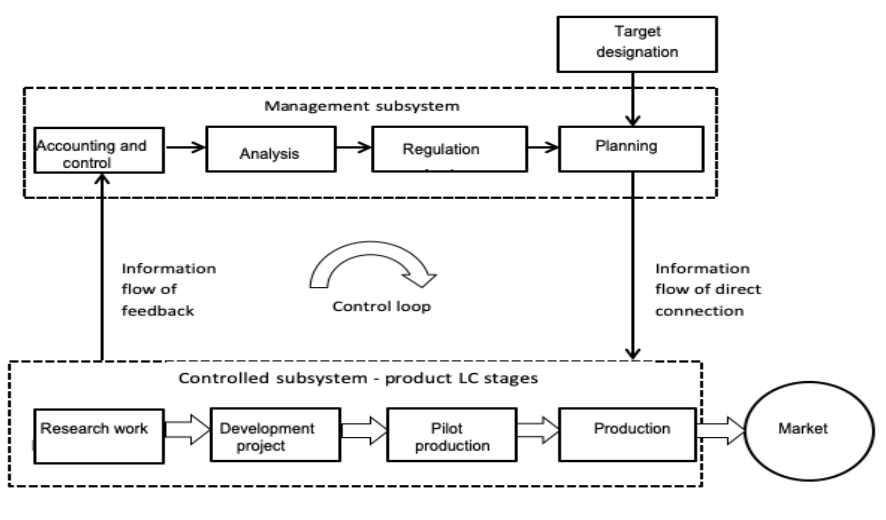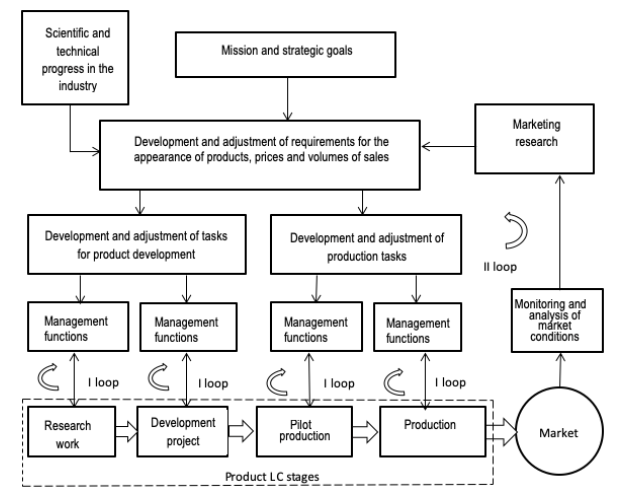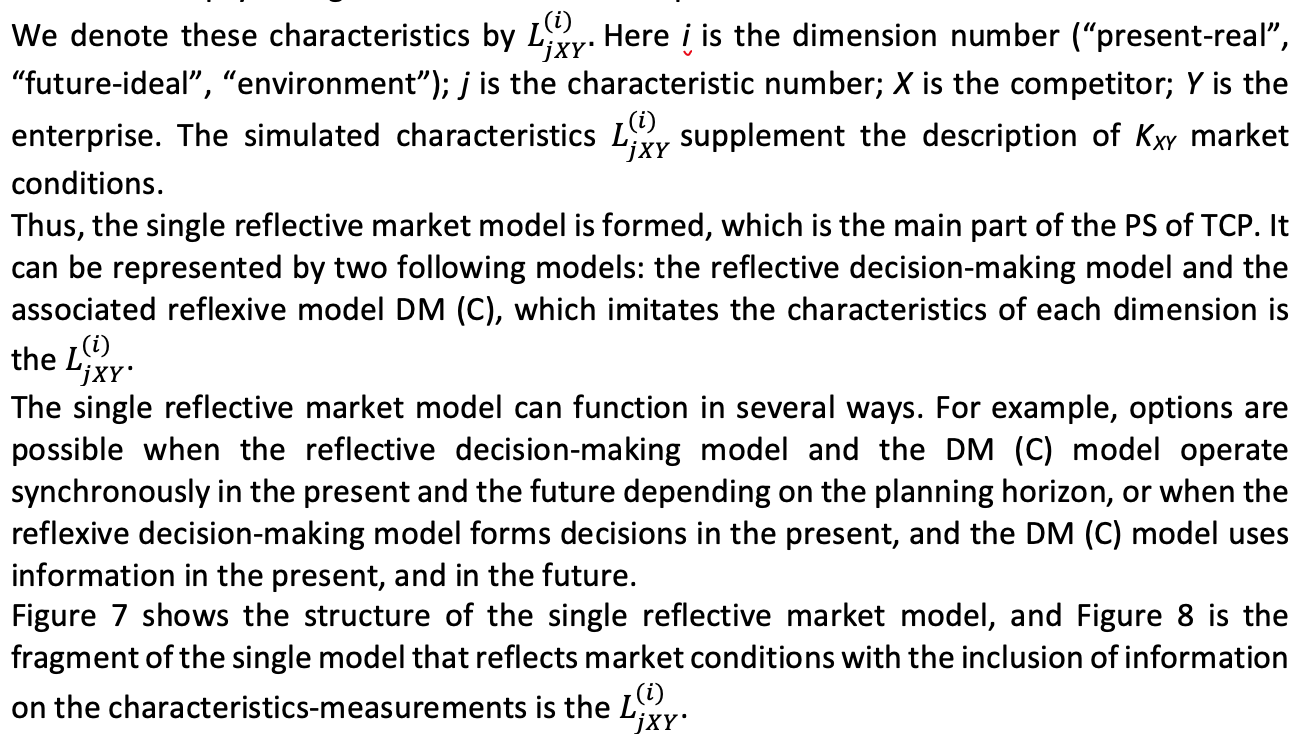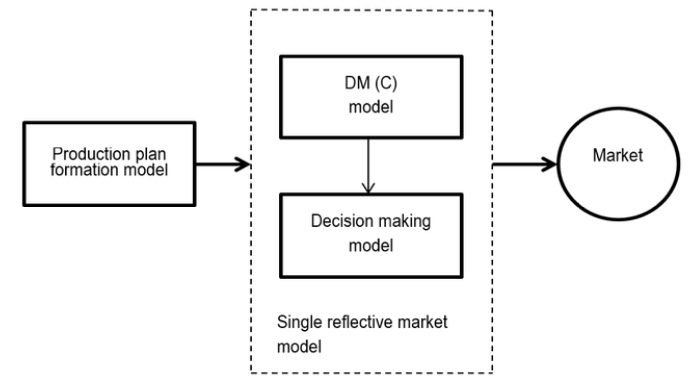

Vol. 41 (Issue 12) Year 2020. Page 23
KHMELEVOY, Vladimir V. 1; VNUCHKOV Yuri V. 2
Received: 28/12/2019 • Approved: 24/03/2020 • Published 09/04/2020
2. PS essence for creating TCP
3. Interaction of the enterprise and market
4. Making planned decisions in the reflection conditions
ABSTRACT: The integrated approach to the development of a planning strategy for the creation of technically complex products (TCP) is proposed. It is based on the concept of the extended life cycle of TCP and includes three aspects of the formation of the decision on the management of production and enterprise behavior on the market. The first aspect is the planning of TCP creation processes within the framework of an external (marketing) control loop. The external loop covers the stages of product creation, monitoring, control, and analysis of the enterprise market. The characteristics of the products can be changed and the planned tasks for their development, production, and logistics can be adjusted as a result of the implementation of the external loop. The second aspect is the adoption of decisions regarding the production and the market policies of the enterprise under the reflection conditions generated by conflicts between market entities. The third aspect is the inclusion of decision makers (DM) in the decision-making process through the reflective display of their socio-psychological characteristics. The proposed approach has a significant degree of innovation, and it is the development of existing decision-making methods in managing the creation of TSP. It broadens and deepens the possibilities of obtaining effective solutions when planning the TCP creation and their implementation on the market. |
RESUMEN: En el presente artículo se propone un enfoque integrado para el desarrollo de una estrategia de planificación para la creación de productos técnicamente complejos (PTC). Dicho enfoque se basa en el concepto del ciclo de vida extendido de PTC e incluye tres aspectos de la formación de la decisión sobre la gestión de la producción y el comportamiento empresarial en el mercado. El primer aspecto es la planificación de los procesos de creación de PTC en el marco de un bucle de control externo (marketing). El bucle externo cubre las etapas de creación de productos, monitoreo, control y análisis del mercado empresarial. Las características de los productos pueden modificarse y las tareas planificadas para su desarrollo, producción y logística pueden ajustarse como resultado de la implementación del bucle externo. El segundo aspecto es la toma de decisiones sobre la producción y las políticas de mercado de la empresa en las condiciones de reflexión generadas por los conflictos entre las entidades del mercado. El tercer aspecto es la inclusión de los tomadores de decisiones (DM) a través de la visualización reflexiva de sus características sociopsicológicas. El enfoque propuesto tiene un grado significativo de innovación y consiste en el desarrollo de métodos de toma de decisiones existentes en la gestión de la creación de PTC. Él amplía y profundiza las posibilidades de obtener soluciones efectivas al planificar la creación del PTC y su implementación en el mercado. |
The planning strategy (PS) for the creation of technically complex products of knowledge-intensive production is a set of approaches, methods and models based on the system analysis principles and providing planning for the products creation in collaboration with various organizations for the development, the production preparation, the product manufacturing, the resource procurement, and the products distribution.
The interaction optimization of various organizational structures and processes in the face of uncertainty and changes allows us to obtain the synergistic effect, improve the management quality of TCP creation, and ensure the achievement of enterprise development goals.
PS of TCP is considered as a holistic system that combines planning procedures for supply chain links. It covers the parent enterprise manufacturing TCP and related enterprises for the resources supply (component parts and materials (C&M)), components, and distribution of finished products. The latter form the inputs and outputs of the PS of TCP as a system.
Figure 1 shows the diagram of the PS of TCP functions. The production program, which includes both directive (special) orders and orders focused on market demand, is the process beginning of forming the PS of TCP. The program serves as the input to the planning mechanism, at the output of which the nomenclature and terms of manufacturing products, the suppliers’ composition of C&M and components, the volumes and terms of their supply, as well as the characteristics of material flows in the distribution network of finished products are determined (Khmelevoy, Naidenov, 2016).
Figure 1
Functions of the PS for creating the TCP

The parent enterprise is interested in ensuring that the products of the C&M suppliers and component manufacturers for TCP meet the requirements for nomenclature and quality as much as possible. Therefore, the parent enterprise also faces the optimal selection tasks of suppliers and relationship management with them. The problem of optimizing the distribution of finished products between consumer organizations is being solved at the outlet of the parent enterprise. If the conditions for participation in the creation of TCP for suppliers are set by the parent enterprise in this case, then the conditions for the distribution of finished products are set either by market demand or by special customers.
There is uncertainty on the border of the parent enterprise and other related enterprises, which is manifested in the following:
Uncertainty also arises in the distribution of finished products due to the fuzziness of assortment demands of consumers, determined by volatile market demand.
Therefore, the development and implementation of the PS of TCP is accompanied by risks, which determines the choice of methods and models of decision-making. Moreover, this subsequently affects the plans quality and the interaction management between the parent enterprise and related enterprises.
Orders in the production program are often associated with new products developed and manufactured at other enterprises, which represent an integrated structure with the parent enterprise, i.e. cluster. The integration basis is the production and technological community of enterprises co-executing innovative projects. The combination of such products forms the innovative portfolio of the parent enterprise, which also can be the innovative portfolio fragment of a higher level, i.e. an industry or a national level.
Before candidate products will be included in the innovative portfolio of the parent enterprise, they must be selected according to a special procedure for compliance with its production and technological profile.
Products included in the innovation portfolio are represented either by a set of design and technological documentation, or finished products as components that have passed the stages of development and production at other enterprises of the cluster.
The systematic idea of creating TCP as an interaction of structures in the supply chain necessitates changing the content of the product life cycle (LC). It is necessary to consider the entire cycle costs when substantiating the volume of investments for the TCP creation, i.e. from the C&M supply to the distribution and sale of finished products.
It is advisable to expand the usual idea of the product LC in connection with this, including in addition to the research and development (R&D) and production stages, supply stages of C&M, components and distribution of finished products (Nechaev, Khmelevoy, 2007).
Figure 2 shows the scheme of the extended life cycle (ELC) of TCP, which includes the traditional LC of TCP, as well as the stages of supply and distribution.
Figure 2
ELC of TCP

There remains planning for the development and production of innovative portfolio products, components and supplies of C&M outside the ELC, as this is an “internal affair” of the relevant organizations that is not directly related to the production of TCP.
The supply stages duration is measured by the products delivery time from suppliers to the parent enterprise, and costs are measured by the price of the delivered products with the addition of logistics costs. The time and cost of distribution of finished products is primarily the logistical cost.
Total investments in the TCP creation within the framework of the ELC increase as the supply of C&M and components progresses until TCP enters the market taking into account preliminary marketing costs. Experience shows that the costs of the parent enterprise for C&M and components are commensurate with the production costs for complex technical systems. The validity of the inclusion in the LC of TCP of new stages follows from this.
Thus, the PS of TCP is built based on the planning of ELC of TCP stages using methods and models that reflect the structure and dynamics of the ELC stages. Systematic and consistent modeling of ELC stages increases the reliability of plans despite the variability and uncertainty of situations inside and outside the enterprise (Vnuchkov, Selezneva, Khmelevoy, 2012).
PS of TCP simulation is developing in the direction from demand for TCP through production to supplies of C&M and components. Another option is also possible when not the market, but special orders determine production tasks, and then we order the C&M and components for these tasks, and distribute finished products. Usually both options apply.
The approach to the PS for the creation of TCP, based on the ELC, is consistent with the concept of horizontally integrated flexible production business systems, when the parent company re-creates its business space for new projects. The parent enterprise creates the most favorable conditions for its activities by optimizing partnerships.
The real interaction of the enterprise and other market entities takes place in conditions of confrontation, conflict, to overcome which the activities of the enterprise are directed through all kinds of production and marketing measures. Traditionally, the process of managing the TCP creation is represented as the functioning of a cybernetic system consisting of two subsystems: the management (control subject) and the controlled one (control object). These subsystems are covered by direct and feedback and together with the subject and the object form the control loop of the object. The controlled subsystem changes its state over time in the direction of maximum approximation to a given target under the influence of the control subsystem.
Figure 3 shows the traditional cybernetic model of the control system (Beer, 2011), in which the object is the development and the product manufacturing, and the subject is the management of this process with its main functions. Such a model exists at every stage of the TCP creation from R&D to production.
Figure 3
Single-loop cybernetic model of
enterprise management system

The target designation source is not shown in this model (single-loop-internal). They can serve as a superior body that directives the planning goals or market demand. The situation changes significantly when the enterprise acts on the market as an object-subject of market management, in the space of which the marketing activity of the enterprise takes place, actively influencing market participants and experiencing market opposition at the same time. Then, the goals determination of creating TCP and their adjustment depends on the prevailing market conditions, i.e. on the identified requirements for the quality of products, their prices, sales, etc., which are indicators of changes in the enterprise’s strategy. And the PS of TCP can be considered in this sense as a marketing strategy for managing product creation.
The marketing component in managing the TCP creation is aimed at ensuring the necessary stability of the control system under the active influence of factors of the internal and external environment. Therefore, the models with the internal loop should be supplemented with the external one, which would include monitoring of market conditions, analysis of market information, comparing market requirements and real capabilities of the enterprise, developing and adjusting appearance of the product, technical specifications for R&D, and production tasks. The external loop is closed to several internal ones for controlling the stages of the product LC and the set of marketing measures is crucial in shaping the goals of the enterprise and in transforming the design and production technology of products to ensure their competitiveness in this sense. Thus, the objects of management and planning are not only the processes of development and production of the product, but also the changes in its appearance and characteristics. This also takes into account the achievements of scientific and technological progress, the resource capabilities and the scientific and technical potential of the enterprise.
Figure 4 shows a dual-loop model of the enterprise management system.
Management of the TCP creation is influenced by a variety of organizational, economic, technological, industrial and marketing factors. This is a space of considerable uncertainty, risks and threats generated by the behavior of competitors, consumers, and other market entities. Effective management of TCP creation requires new approaches based on modern methods that consider the behavioral nature of market entities (Khmelevoy, Teplov, Davydov, 2015).
Figure 4
Dual-loop model of the enterprise management system
I – internal control loop; II- external control loop

There is a conflict between the enterprise and the market structures with opposite interests in different directions at the junction of production and marketing of products: prices, quality of products and supplies, sales volumes, relation to the products brand, enterprise image, etc. This conflict proceeds in the form of reflective management, theory which was developed in the late 1960s by V.A. Lefebvre. Reflexive management is considered as a “process of transferring the basis for decision-making by one of the opponents to another opponent” (Lefebvre, 1973), which is an instrument of influence on market participants in the enterprise interests.
Now we are going to consider the process features of making planned decisions with reflective management in the market environment. The market is a multilayered complex phenomenon at the intersection of various spheres of human activity, which reflects economic, political, social, and psychological interests of both individuals and business groups. The enterprise faces significant difficulties when entering the market with new products if it does not take into account the behavioral aspect of market participants when developing planned decisions. The market is not passive. It actively opposes the enterprise, spontaneously or knowingly imposing its own manner of behavior on it. Consequently, the decision-making model that the enterprise has not only depends on the behavior of market entities, but also affects their behavior and their decision-making.
Market entities are in a state of continuous reflection in other word. It is possible to include the factor of reflexive interaction in the process of developing planned decisions within the framework of the marketing strategy for creating products in this regard. Involving the behavioral aspects of the interaction of market entities in the context of limited economic means provides the additional resource to increase the success and security of the enterprise in the face of threats from competitors and consumers.
We distinguish the following from the many characteristics that determine the behavior of an enterprise in the market: activity purpose, market conditions, methods and models of decision-making to achieve the goal, and decisions made that are transformed into real actions of the enterprise in the market. The goal may be to make profit, ensure business security, expand, deepen and hold the market, increase competitiveness, etc. The market conditions are described by many indicators, such as market capacity, average price and profitability, type of competition, market share of competitors, competitiveness of their products, etc. Decision-making methods are applied depending on how the company evaluates the market conditions. These methods can be economic, organizational, technological, marketing, logistic, etc. Decision-making results and their implementation, followed by monitoring and analysis of the enterprise’s activity in the market in the marketing management loop, will affect different stages of the product creation LC in different ways. Threats of erroneous decisions are most dangerous in the early LC stages.
The function of forming target designation in the enterprise management system is performed by the marketing service. It determines in which direction the appearance of the product should be created or changed, which is then specified in the terms of reference for R&D, in tasks for production volumes and production time. The role of marketing services especially increases when decisions are made taking into account the reflection, which requires deep penetration into the intentions of competitors.
We consider two conceptual schemes for the development of planned solutions (Gyazova, Khmelevoy, 2017). The first, traditional decision-making model can be represented as the following scheme:
![]()

The vertical bar (|) in (1) means “correlation (comparison)” of circuit elements. The initial objective market conditions K is displayed by the enterprise in any way in the KX form, with which the goal ZX is compared. The DX solution is formed to achieve the ZX goal based on KX information by applying some method or MX method.
Monitoring the implementation of the solution allows us to analyze its effectiveness and make changes to the product appearance in the marketing management contour, if the goal is not achieved. The modified product re-enters the market after the product is launched into development and/or production. Thus, the internal and external control loops are connected, inside of which information of direct and feedback connections is continuously circulating.
The traditional decision-making model is shown in the Figure 5.
Figure 5
Dual-loop model of the enterprise management system

The picture changes significantly when the reflection is included in the decision-making process, i.e. the enterprise significantly expands the information base for decision-making, increases their viability and accordingly strengthens its position in the market. The following decision-making model taking into account reflection is more substantial than model (1):

The enterprise-subject of the market that carries out reflection is indicated by the index Y, and the enterprise-object of reflection is indicated by the index X in the presented chain of actions. The actions meaning of the enterprise Y is disclosed as follows:

Figure 6
Dual-loop model of the enterprise
management system

Сomparing the traditional and reflective decision-making model, the development of decisions in the PS of TCP under the conditions of reflection is carried out in the two following stages: information about the competitor’s strategy is obtained at the first stage, and this information is included in the decision-making process at the second stage. The development and implementation of these stages requires organizational and economic support in the form of a special marketing service, endowed with the functions of forming decisions, monitoring and analyzing the results of their implementation and together with other R&D departments and participating in the development of measures to increase the competitiveness of products ultimately.
The study of reflective management in the economic sphere is associated with great difficulties. But it leads to a deeper understanding of the interaction mechanism of conflicting parties. The subjective factor is crucial in making decisions in the context of reflection, since the receipt and use of information about the competitor with its subsequent implementation in the decision-making scheme substantially depends on the socio-psychological characteristics of the market entity, affecting the goals and objectives of its activity.
We can use the well-known “I-image” personality model (Agapov, 2012) to describe the enterprise-competitor relationship, extending it to a group of interested persons whose behavior is analyzed in a specific socio-psychological environment. The subjects are decision-makers (DM) in the context of a reflective decision-making model. They can represent both the interests of the enterprise is the DM (E), and the competitor is the DM (C).
Each subject is considered in complex interaction with the outside world and with himself in a decision-making model with the DM participation (DM model). The interaction proceeds in three following dimensions:
The DM model allows taking broader look at the decision-making process in reflection terms, when three conflict dimensions are imitated: a competitor's vision of his business in the present, his business view in the future and his view of how the market environment perceives it. The significance of the subjective, behavioral factor is also determined by the fact that the conflict takes place not only between the enterprise and the competitor, but also inside the DM itself is also in three dimensions, from the analysis of which the enterprise clarifies its position in relation to the competitor, based on the vision of its goals and of opportunities.
The each dimension content of the subjects’ relationships in the market is determined by the following characteristics:

Figure 7
Dual-loop model of the enterprise
management system

-----
Figure 8
Fragment of the single
reflective market model

The important problem of the practical application of reflective models is obtaining data on the elements of the external environment (first of all, on competitors), as well as assessing the quality of these data. The decision success depends on the information reliability about the elements of the decision-making scheme: if the information reliability is low, at least one of the elements can produce a result opposite to the expected one. Therefore, it is desirable to initially have a preliminary assessment of the information quality about the market, about the competitor, about his intentions and behavior in the form of the following characteristics at least:

The following features of the PS for the TCP creation can be noted:
The above features of the PS of TCP set the direction for creating a new type of information management systems, when complex multi-aspect relationships between enterprises and market elements, modeled taking into account reflective behavioral aspects, become the leading value in decision-making.
The proposed comprehensive approach to the development of the PS TCP integrates the internal and external activities of the enterprise into a holistic system using the reflection factor in the interaction of market entities. This is the innovation of this approach, which is the development of existing decision-making methods in managing the creation of TCP.
The originality of the proposed concept is in a significant expansion of the management functions within the marketing contour of managing the creation of TSI, taking into account the behavior of competitors. The structure of PS TCP represents the content of enterprise management broader and deeper, covers the marketing environment, external logistics, and stages of the product life cycle. At the same time, at the final phase of the decision-making process, the enterprise includes simulated elements of decision-making by competitors. The proposed approach broadens and deepens the possibilities of obtaining effective solutions when planning the creation of TCP and their implementation on the market.
Agapov V.S. (2012). The formation of "I-concept" in the management activities of leaders. Moscow: Alteks.
Beer S. (2011). Cybernetics and Management. Moscow: KomKniga.
Gyazova M.M., Khmelevoy V.V. (2017). The concept of making marketing decisions in terms of reflection. Russian Economic Internet Journal. 4, 1-10.
Khmelevoy V.V., Naidenov A.V. (2016). The optimal composition of scientific and production associations determination in the creation of high-tech complexes. Economics and Entrepreneurship. 11(2), 171-174
Khmelevoy V.V., Teplov Yu.A., Davydov A.D. (2015). The control system for the creation of new technology in the technology of breakthrough development, in the collection. National interests: priorities and security. 11(9), 26-39.
Lefebvre V.A. (1973). Conflicting Structures. Мoscow: Sovetskoe radio.
Litvak B.G. (2009). Expert information: methods of obtaining and analysis. Мoscow: Research Center for the Problems of Quality Training of Specialists.
Melnikova G. (2008). Forecasting Innovation. Мoscow: Publishing House of Moscow Aviation Institute.
Nechaev P.A., Khmelevoy V.V. (2007). Project management in mechanical engineering. Мoscow: ECOSTAR.
Vnuchkov Y.A., Selezneva N.A., Khmelevoy V.V. (2012). Selection of an information platform for a machine-building enterprise management system, in the collection: Management, finance, marketing of innovative developments in industry. Мoscow: Moscow State Aviation Technological University.
Zvyagintseva I.I., Khmelevoy V.V., Zueva T.I. (2016). Using a method based on fuzzy inference in managing the airline’s internal risks. Bulletin of the Moscow Aviation Institute. 23(1), 259-268.
1. PhD in Technical Sciences, Docent, Department of Innovative Economics, Finance and Project Management, Moscow Aviation Institute (National Research University), 125993, Russia, Moscow, Volokolamskoe highway, 4. E-mail: kaf505@mai.ru
2. PhD in Economics, Docent, Department of Management and Marketing of High-Tech Industries, Moscow Aviation Institute (National Research University), 125993, Russia, Moscow, Volokolamskoe highway, 4. E-mail: yury_vnuchkov@mail.ru
[Index]
revistaespacios.com

This work is under a Creative Commons Attribution-
NonCommercial 4.0 International License